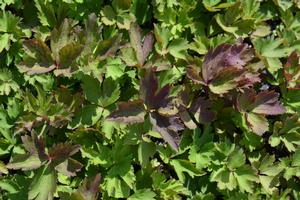New Moon Nurseries
Anemone virginiana
Thimble weed
Native to North America
FIRST IMPRESSIONS: Anemone virginiana is a graceful perennial wildflower. In summer white flowers are displayed on slender stems above clusters of attractive lobed leaves. Flowers have a greenish centers and are followed by interesting green thimble shaped seed clusters.
HABITAT & HARDINESS: This native is found in moist meadows and prairies, savannas, moist open woodlands an along the edges of woods and thickets. Range extends throughout Central and Eastern portions of the United States and into Canada. Scattered populations exist further south in Louisiana, Mississippi and Alabama.
Plants are hardy in USDA Zones 3-8.
PLANT DESCRIPTION: Anemone virginiana has an upright and airy appearance. The lobed leaves are attractive and dark green with long petioles (leaf stalks). Foliage is usually healthy since leaves contain a chemical that repels insects and mammalian browsers.
Flowers are solitary with 5 white petal-like sepals and numerous greenish stamens. Blooms are very showy in spring and early summer. When in full bloom, flowers are reminiscent of tiny white poppies.
After the white sepals fall, a green thimble-like fruit cluster remains. It is about an inch long and remains green for a while before turning into a fluffy mass of seeds.
Plants are about 3’tall. Space plants 1’ apart and they will usually give good coverage the first year.
CULTURAL & MAINTENANCE NEEDS: Culture is easy as long as plants have part sun or part shade and a moist soil.
Plants tolerate alkaline pH, clay soils and some drought.
Flowering may stop if plants become too crowded. The remedy for the situation is to divide plants in the fall.
Expect a plant to spread from rhizomes but not nearly as rampantly as its cousin Anemone canadensis.
LANDSCAPE USES: Useful as a Mass or Groundcover in Shade Gardens or other moist partly sunny or shaded sites. Can be used as an Accent or as part of a Group. Plants provide Showy Blooms, interesting Fruit and are valuable components of Cottage Gardens, Deer Resistant Plantings, Meadow or Prairie Gardens, Perennial Borders and Wildlife Gardens.
COMPANION & UNDERSTUDY PLANTS: Anemone virginiana mingles successfully with Amsonia tabernaemontana, Aster cordifolius, Phlox divaricatus and Carex amphibola.
If a substitute is needed, take a look at Anemone canadensis.
TRIVIA: Like other members of the Buttercup Family, the showy flowers of Anemone virginiana actually have no petals. Instead they have colored sepals.
Beneficial native bees and other pollinators visit the flowers usually seeking pollen rather than nectar.
Tall Anemone produces allelopathic chemicals that inhibits or stunts the growth of neighboring plants.
This species is very similar in appearance to Anemone canadensis. The easiest way to differentiate is to remember that Anemone virginiana has long leaf stalks and Anemone canadensis is sessile (with no leaf stalk). Also as far as habitat goes, Anemone virginiana is the more shade loving of the two. It is usually found near wooded areas while Anemone canadensis prefers sun.
Height:
3 ftSpread:
1-2 ftSpacing:
18-24 inUSDA Hardiness Zone:
3-8Bloom Color:
WhiteAnemone virginiana Characteristics
Attributes
- Drought Tolerant
Exposure
- Full Sun
- Shade
- Partial Shade
Deer Resistant
- Deer Resistant
Flowering Months
- June
- May
Foliage Color
- Green
Juglans nigra Tolerance (Black Walnut)
- Yes
Soil Moisture Preference
- Moist
Interesting Notes:
For more information on this plant, visit the USDA PLANTS Database:http://plants.usda.gov/java/profile?symbol=ANVI3
